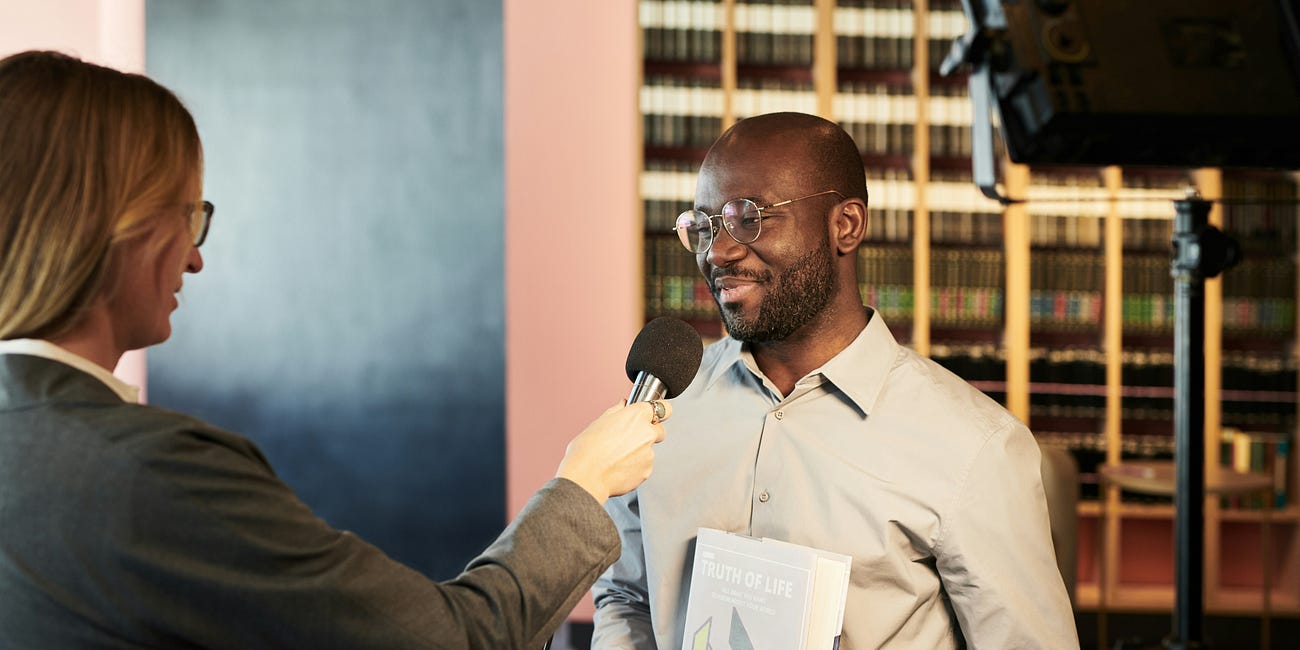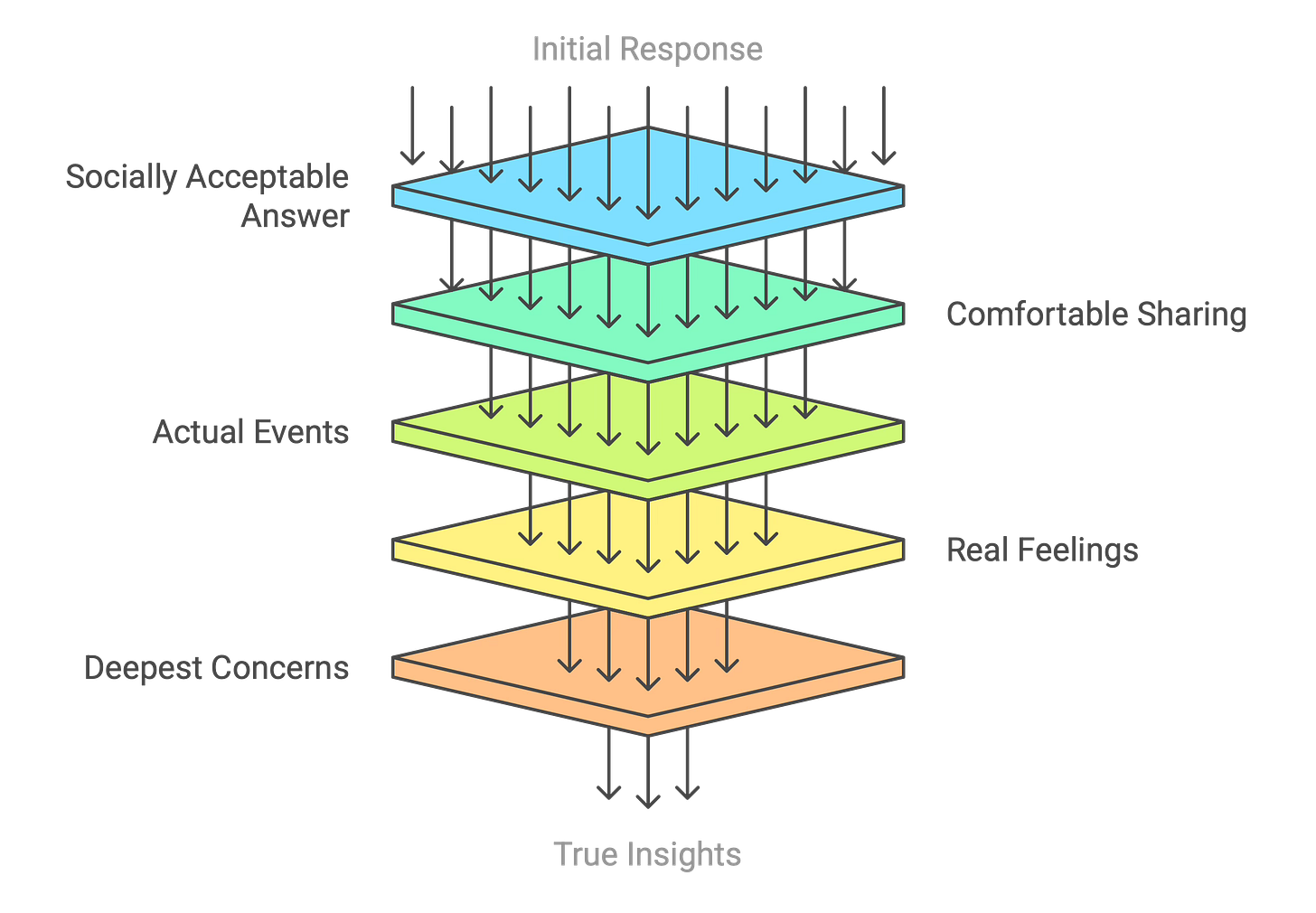If Medium is your go-to reading spot, you can catch this post there too! Just click here.
"Our sustainability initiative is going really well, we have all the stakeholders on board."
I nod, pen poised. The executive across from me leans back, clearly feeling like they have answered my question. They haven’t.
"Really well" tells me nothing. It's a placeholder, a conversational traffic cone marking where an actual answer should be. But here's where most interviewers make their mistake: they move on to the next question.
Not today.
"That’s very good to hear…" I lean forward slightly, "Could you tell me more about the experience of getting to this successful outcome?"
Their expression shifts. They take a breath.
"Honestly? I thought we'd have a mutiny. When we announced the plastic packaging phase-out, our biggest retail partner threatened to drop us. I wasn't sleeping. My boss was calling me every morning at 6 AM asking if we still had a business."
Now we're getting somewhere.
Have you read the article below? What you’re reading right now covers strategies that you can use after the first 90 seconds.
The First 90 Seconds: Setting the Stage for Authentic Responses
·If Medium is your go-to reading spot, you can catch this post there too! Just click here.
Digging Down to Layer Three
Here's what years of interviewing have taught me: the first answer is almost always the socially acceptable answer, the safe answer, the answer they've been trained to give.
Here’s a way to think about responses from your participants:
Many interviews never get past the first layer (socially acceptable answers). Good interviews reach layer two (comfortable sharing). But the magic - the insights that change how you understand a problem - lives in layers three through five (actual events, real feelings and deepest concerns).
And the only way to get there is mastering follow-up questions.
Why We Accept Surface Answers
Before we dive into techniques, let's be honest about why most of us are not so good at follow-up questions:
😳 We're afraid of awkwardness. Pushing past someone's first answer feels uncomfortable. What if they think we're prying? What if they get defensive?
⏱ We're watching the clock. We have 12 questions to get through in 45 minutes. No time for diving deep when we need to cover everything.
🖌 We're note-taking, not listening. While they're answering, we're frantically scribbling (or typing) and thinking about our next question. We miss the gaps in their story.
✔️ We mistake data for insight. They gave us an answer and we check that box. Next question. We confuse collecting responses with understanding reality.
But here's the thing. Your participants often do want to tell you more and are just waiting for permission!
Would you like to see an interview extract demonstrating a powerful interviewing strategy? Scroll to the bottom of the page for a little bonus!
Five Strategies That Actually Work
1. Get Specific
Turn vague into vivid by asking for concrete details.
💁🏽♂️ They say: "Our app rollout was difficult."
🕵️♀️ You ask: "Walk me through the most challenging day. What time did you get to the office, and what time did you leave?"
Why it works: Specificity bypasses the part of their brain that creates polish. When someone recreates a specific moment, they can't help but include the messy details.
2. Get Granular
Break down broad statements into smaller, manageable pieces.
💁🏼♀️ They say: "We had to restructure the whole approach."
🕵️♀️ You ask: "Take me through that step by step. What did you change first?"
Why it works: Big, vague statements often hide multiple smaller truths. When you ask people to break things down into pieces, they reveal details they wouldn't think to share otherwise.
3. Get Curious
When something doesn't add up, gently point it out.
💁🏿♂️ They say: "It was a smooth transition."
🕵️♀️ You ask: "Smooth is interesting… because earlier in our conversation you also said you weren't sleeping. What made it feel smooth despite that?"
Why it works: Contradictions aren't lies - they might just be incomplete truths. Exploring them reveals complexity.
4. Get Hypothetical
Use imagination to bypass defensiveness.
💁🏽♀️ They say: "We couldn't have done anything differently."
🕵️♀️ You ask: "If you were advising a friend facing the same situation, what would you tell them to watch out for?"
Why it works: Hypotheticals create psychological distance. It's easier to be critical about imaginary scenarios than real ones.
5. Get Quiet
Sometimes the best follow-up isn't a question at all.
🤷🏼♂️ They say: "It was fine, I guess."
🕵️♀️ You do: Count to five in your head. Maintain eye contact. Wait.
💁🏼♂️ They continue:"Actually, 'fine' isn't the right word..."
Why it works: Most people can't stand silence. They'll fill it, and what they fill it with is usually more honest than their first answer.
Reading the Cues: When to Push and When to Pivot
Not every answer needs a follow-up. Here's how to recognise the moments that matter:
Dig deeper when you hear:
Minimising language: "Just," "only," "simply," "basically"
Vague evaluations: "Good," "fine," "okay," "successful," "challenging"
Passive voice: "Mistakes were made," "It was decided"
Time jumps: Going from "We started the project" to "It launched" with nothing in between
Emotional flatness: Describing dramatic events in monotone
🤚🏼 Pivot away when you notice:
Genuine distress: They're reliving trauma, not just discomfort
Legal or confidentiality boundaries: "I probably shouldn't say more about that"
Repetition: They're saying the same thing different ways
Closed body language escalating: Arms crossing, leaning away, checking the time
The well is dry: They've given you everything they have on this topic
The Truth About Truth
Here's what I've learned: people don't withhold the truth because they're deceptive. They withhold it because they're human. They're protecting themselves, their colleagues, their companies. They're managing impressions. They're avoiding pain.
Your job is to make truth-telling feel safer than the alternative.
When you ask follow-up questions with genuine curiosity, when you create space for complexity rather than demanding simplicity, when you honour their experience rather than just extracting their data, that's when the real stories emerge.
The best insights I've ever gathered didn't come from particularly clever first questions. They came from listening carefully and then being willing to ask the second question, the "help me understand" question.
The best insights come from believing that behind every corporate cliché is a human being with a real story. And that story is always worth the extra question.
I'm Andrea, a management consultant with over a decade of experience across industry and academia. I work with commercial, non-profit, academic and government organisations worldwide, helping them capture meaningful insights through mixed methods research.
I write about practical frameworks to help you discover what others miss. My main goal is to translate complex concepts into techniques that readers can use immediately.
A Little Bonus: Interview Example
The below is an interview extract that demonstrates the power of probing. Like the intro to this article, I centred it around sustainability. Take a look!
Layer One (The PR Answer)
Me: "How's the zero-waste target going?"
Them: "We're making excellent progress toward our 2026 goals."
Layer Two (The Professional Truth)
Me: "What kind of progress?"
Them: "We've reduced landfill waste by 30% and increased recycling rates across all facilities."
Layer Three (The Real Story)
Me: "That's impressive. What's been the biggest surprise along the way?"
Them: "How hard it was at the beginning. Week three, I was standing in our main warehouse looking at a mountain of contaminated recyclables. The night shift had been throwing everything in the recycling bins—pizza boxes, coffee cups, everything. Three weeks of 'recycling' headed straight to landfill."
Layer Four (The Emotional Truth)
Me: "What was going through your mind as you saw that?"
Them: "That I'd completely underestimated the human side. I had this beautiful spreadsheet showing cost savings and waste reduction. But I hadn't thought about asking the warehouse workers what happened during their 3 AM breaks when the only food available came in non-recyclable packaging."
Layer Five (The Deep Insight)
Me: "You said 'the human side'—what else had you missed?"
Them: [long pause] "That sustainability isn't about perfect systems. It's about imperfect people trying to do better. I was so focused on hitting numbers that I forgot we were asking people to change twenty-year habits overnight. The spreadsheet said we'd save money. The reality was we needed to invest in hearts and minds first."
See? That's the difference between "excellent progress toward our goals" (Layer One response) and an insight that actually helps someone and others might learn from (Layer Five response).




This. This is true in social settings too. As an HSP - I get tired of people just brushing the surface when conversing. Same tropes same mediocre answers. Same conversations - it’s rare to find people who are willing to go deep. Thanks for the graph, did you come up with this? 🙌🏻
Thank you very much, Andrea. Great insights and very well described! The usual advice that we all should improve our listening skills is usually quite unspecific. You make it much more specific what good listening is about. This is really helpful. I especially liked the expression of ‘creating space for complexity rather than demanding simplicity’ in conversations.